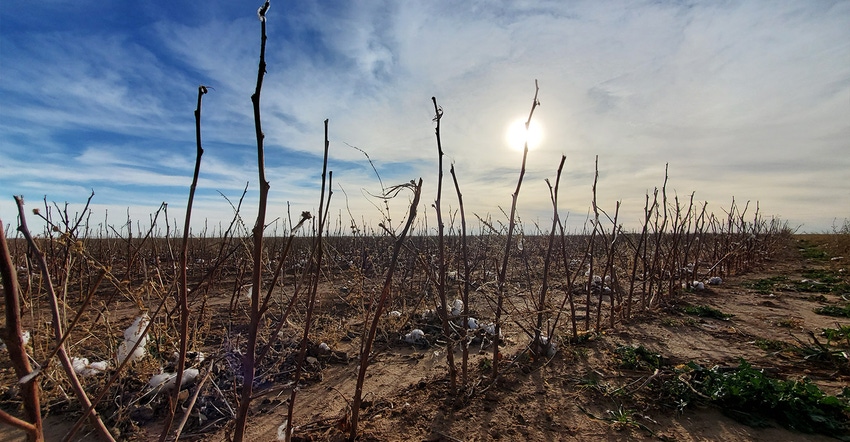
Texas Commissioner of Agriculture Sid Miller has granted a ten-day extension for cotton stalk destruction for growers in Texas Boll Weevil Eradication Foundation eradication zone 1.
In a letter to the Texas Boll Weevil Eradication Foundation, Commissioner Miller said: “Pursuant to the extension request I received from Mr. Joe Pennington, Chairman of the Cotton Producers Advisory Committee in Pest Management Zone 1, and after reviewing the foundation’s evidence of the current conditions in Zone 1, I agree the cotton stalk destruction deadline for Zone 1 should be moved by ten days to accommodate farmers in that area.”
The stalk destruction deadline moves from Sept. 1 to Sept. 10. As of August 30, stalk destruction deadlines in all other South Texas zones remain the same.
Pennington says a combination of unusual weather events put the LRGV cotton crop significantly behind.
“We had an extremely dry planting season,” Pennington says. “A lot didn’t come up, then we got rain, and some did germinate. But it was a real late start.”
He says dry conditions early resulted in irregular stands. “We had two or three stages of cotton in the same row.”
He says growers lost some cotton to summer rains. “Some flooded out and some got set back, so we had a hodgepodge of maturities.”
He says the late rain also helped the crop. “Our new cotton varieties will make a lot of cotton with the right amount of water. For now, we have a fair crop, not a home run, but a decent crop.”
Late crop
But it’s late, and with a Sept. 1 stalk destruction deadline looming, producers faced stiff fines if they had hostable cotton still in the fields past that date.
“I don’t think 50% of the LRGV crop is harvested (on August 30),” Pennington says. “We did not need to get fined, so we made the request for an extension.”
It was not a sure thing, he adds. “I’ve been on the Cotton Producers Advisory Committee for a long time. The only time we had ever gotten an extension in the past was after a hurricane. This year, cotton producers have a crop they need to gather, especially at 90-cent cotton. We just needed a little more time.”
Program is working
He says LRGV growers realize that the longer they have plants in the field, the more opportunity they have for boll weevils to come in. “The longer the cotton is out there, the longer we have to spray,” he says. “We are close to getting this program done. We are spraying less this year than any year before. Also, Mexico is doing a good job.”
The late crop, however, made an extension advisable. “Last week we requested an extension and got an extra ten days. We are thankful that Commissioner Miller agrees.
Non-hostable
“Our goal is to have all our cotton non-hostable by September 10.”
He explains that cotton does not have to be harvested and stalks shredded to be in compliance. “If it’s all defoliated, it should be hon-hostable. We can still have cotton left to harvest and be compliant. We hope by Sept. 10 it will all be non-hostable.”
Pennington says LRGV cotton producers believe the eradication program is working. “We don’t want anything to hurt the program, but we thought this request was in the best financial interest of producers down here.
“If we keep growing cotton, we have to eliminate the boll weevil. If we did not have eradication in the Valley and had boll weevils like we did in the 60s, we would not see any cotton planted.
“We want to eradicate the boll weevil. It still costs us money and still costs the State of Texas money. It would be a disaster if it’s not funded. We are close to finishing; we need to get the job done.
“I hope good weather stays with us, we get the crop out, stalks destroyed, and get ready for another year. We hope Mexico is successful with their program.”
TBWEF Chief Operating Officer Patrick Burson says the Foundation is working with other South and Southwest Texas farmers and cotton organizations to determine best approaches for stalk destruction and pending deadlines.
“It’s important to render cotton plants non-hostable,” Burson says. He agrees with Pennington that the key is “non-hostable. Defoliated and all dried up is compliant,” he says.
Click here, for more information on stalk destruction.
About the Author(s)
You May Also Like






